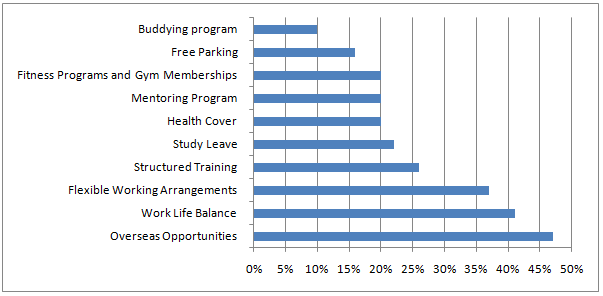Carrots and sticks to attract graduate engineers

There’s been a lot of talk about the two speed economy in Australia and we’re clearly feeling it in the water industry where attracting and keeping good employees is proving to be a challenging task when competing with more lucrative salaries, particularly in the mining game.
In 2010 qldwater produced The Queensland Urban Water Industry Workforce Composition Snapshot which confirmed the complex challenges facing the Queensland water industry to attract and retain skilled workers. As the baby boomers get their fishing gear and Winnebago’s ready for a well-deserved retirement and the rest of the nation is apparently enjoying the resources boom with its promise of a hefty pay cheque, we are left scratching our heads trying to think of ways to ensure a sustainable workforce to take care of the world’s most important – but perhaps least recognised – resource.
Providing cadetships and graduate programs for undergraduates and graduates to enter the industry – especially in the engineering field where industries such as mining and consulting can offer far more attractive salaries – is one particular area where we could potentially do more.
Cadetships link tertiary students with employers in an arrangement involving benefits such as paying HECS/ HELP fees, providing text book allowances, full paid work during semester breaks, pay during study and on-the-job training while graduate programs offer recent graduates the opportunity to get paid work experience in their field with benefits such as payment of outstanding study fees, mentoring and job rotation programs.
Many water service providers in Queensland do offer cadetships and graduate programs in order to attract and retain skilled workers in key fields such as engineering. Indeed, local and state government is often recognised as an excellent training ground where cadets and graduates get the opportunity to be exposed to big infrastructure projects. However, we have struggled to try to capture and share knowledge about the schemes that work well. We hear stories about impediments including the dreaded rotational approach – where cadets and graduates are captured by other engineering disciplines in council before they get the chance to realise their potential in water (let’s not pull punches, it’s those roads people). Where it does work, often it just magically happens – driven by relationships and the right combination of cadet/ graduate and mentor.
On completion of their qualification engineering graduates these days can pretty much pick and choose from a wide range of job opportunities and, compared to graduates from other fields, they have a higher rate of full time employment post completion of their qualification (except for chemical engineering graduates).
The average post study fulltime employment rate across all fields is 76.3 % where for engineering graduates this can be as high as 97.3%.
A Gradcareers survey also shows that the median starting salary for engineers, at $60,000, is significantly higher than the $50,000 average for other fields – in regional communities experiencing the effects of a resource boom the starting salary can be considerably higher.
Whilst for some graduates the more lucrative pay rates and benefits offered by private companies may entice them into sectors such as mining, a good pay packet is not the only way to attract good people to the industry, and this is where we believe we can do more.
A recent survey conducted by Gradconnection provided an overview of the benefits that graduates look for and interestingly, after overseas opportunities as the most highly ranked benefit, work life balance featured high to 41% of graduates. This is something that some of the higher paying industries may not be able to offer.

While overseas opportunities may not be a benefit many water service providers can provide (although exchange programs with international partners could be a possibility), we could definitely do more in the areas of work-life balance, flexible working arrangements, structured training and study leave benefits to attract graduates.
The Gradconnection survey showed that just over half of the graduates in full-time employment learned of their current employment first through one of three strategies: searching advertisements on the internet (26.4%), talking to family or friends (14.5%) and visiting university or college careers services (10.3%). Interestingly, only 5.8% found their role through careers fairs, which are often a costly exercise for businesses with clearly limited return on investment.
An area of potential perhaps previously not significantly explored by the water industry is university careers services. University careers advisors may have a limited understanding of the opportunities available in the water industry and providing them with information and resources to make graduates aware of opportunities in the water industry has the potential to attract more graduates.
Individual Councils and water service providers can also highlight these benefits in career advertisements and promotional materials to attract graduates looking for more than just money.
As an example, one State Government Department operated an engineering scholarship/ graduate program which aimed to fill approximately ten positions per year. The students were approached in their second or third year and invited to enter into an agreement which provided paid vacation work experience during the remainder of their course, a nominal scholarship/ stipend for the remainder of their course and a guaranteed temporary position following the completion of their qualification.
The students were “bonded” to the organisation for a period of employment equivalent to the period they had been supported in their studies (typically three years). This overall approach is not uncommon.
The agency supported the program through a number of additional mechanisms including direct marketing to students at lectures; inviting all potential participants to visit the workplace and interact with their potential future colleagues and senior management in a casual/ BBQ-style environment prior to the application for scholarship/ graduate program; and focussing messages on an honest reflection of the work and working environment (an opportunity to be involved in large scale infrastructure projects, flexible working hours) which differentiated the agency from other more financially lucrative employers, rather than attempting to compete in a market where it could not.
The learnings from this approach included:
- A much better fit between the types of graduates and the work requirements leading to real improvements in retention
- A better overall standard in graduates employed by appealing to those seeking job satisfaction and work-life balance for example over financial factors
- A chance to build relationships and experience over time and positively influence the students’ study choices to be more relevant to the workplace.
In general, bonding arrangements did not work well leading to resentment from some graduates and a number choosing to break contract in spite of potential financial penalties (which were rarely enforceable due to legal costs). In addition, the agency had to be prepared to back up its promises which was typically achieved at a workgroup level but threatened at times at an executive level.
Later this year we will be updating our snapshot report to see how things have changed over the past two years. In the meantime we would like to hear about your successes and failures in graduate programs or cadetships and any other benefits you think we can provide to attract the right people to the right jobs.
Survey Links -
http://www.gradconnection.com.au/blog/post/australian-graduate-statistics/
http://www.graduatecareers.com.au/wp-content/uploads/2012/01/gca002770.pdf Back to list